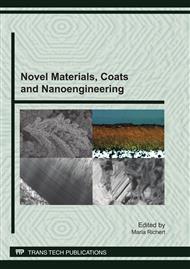p.1
p.11
p.19
p.29
p.41
p.47
p.53
p.61
Processing of Materials by Electric Discharge Assisted Mechanical Milling
Abstract:
Advanced materials manufacturing methods require clean, non-polluting, high speed and precise processes, and should result in highly reliable final products. However, traditionally, many functional materials are synthesized by slow reaction techniques that are both energy and time consuming. In such cases there is strong demand for more appropriate materials processing methods that could offer increased rapid reaction rates and energy efficiencies, and be environmentally safe. Electric discharge assisted mechanical milling (EDAMM) is a new and exciting materials processing technique which combines the attributes of conventional mechanical and mechanochemical milling with the several additional processing effects which can be generated by the simultaneous application of electric discharges. It is shown that EDAMM can be applied to synthesize a range of functional materials in a matter of minutes, rather than the hours or days required using traditional techniques. This presentation provides an overview of recent developments in the EDAMM method and its application to rapid materials processing, and the synthesis of certain functional materials. In this report, we demonstrate the versatility of EDAMM by; (i) synthesis of hard materials, (ii) synthesis of functional oxides used in electronic, magnetic and optical applications, (iii) rapid reduction reactions including extraction of metals from oxides and sulfides and (iv) synthesis of fine metallic and nonmetallic powders and (v) formation of nano- fragments, including carbon nanoribbons and iron oxide nanorods.
Info:
Periodical:
Pages:
29-39
Citation:
Online since:
February 2011
Authors:
Price:
Сopyright:
© 2011 Trans Tech Publications Ltd. All Rights Reserved
Share:
Citation:


